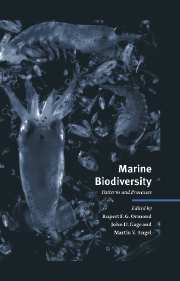Book contents
- Frontmatter
- Contents
- List of contributors
- Foreword: The value of diversity
- 1 Marine biodiversity in its global context
- 2 Gradients in marine biodiversity
- 3 Pelagic biodiversity
- 4 Biological diversity in oceanic macrozooplankton: More than counting species
- 5 Large-scale patterns of species diversity in the deep-sea benthos
- 6 Diversity, latitude and time: Patterns in the shallow sea
- 7 High benthic species diversity in deep-sea sediments: The importance of hydrodynamics
- 8 Diversity and structure of tropical Indo-Pacific benthic communities: Relation to regimes of nutrient input
- 9 Why are coral reef communities so diverse?
- 10 The biodiversity of coral reef fishes
- 11 The historical component of marine taxonomic diversity gradients
- 12 Population genetics and demography of marine species
- 13 Discovering unrecognised diversity among marine molluscs
- 14 Ecosystem function at low biodiversity – the Baltic example
- 15 Land–seascape diversity of the USA East Coast coastal zone with particular reference to estuaries
- 16 The development of mariculture and its implications for biodiversity
- 17 Protecting marine biodiversity and integrated coastal zone management
- 18 Conserving biodiversity in North-East Atlantic marine ecosystems
- Author index
- Species index
- Subject index
3 - Pelagic biodiversity
Published online by Cambridge University Press: 04 August 2010
- Frontmatter
- Contents
- List of contributors
- Foreword: The value of diversity
- 1 Marine biodiversity in its global context
- 2 Gradients in marine biodiversity
- 3 Pelagic biodiversity
- 4 Biological diversity in oceanic macrozooplankton: More than counting species
- 5 Large-scale patterns of species diversity in the deep-sea benthos
- 6 Diversity, latitude and time: Patterns in the shallow sea
- 7 High benthic species diversity in deep-sea sediments: The importance of hydrodynamics
- 8 Diversity and structure of tropical Indo-Pacific benthic communities: Relation to regimes of nutrient input
- 9 Why are coral reef communities so diverse?
- 10 The biodiversity of coral reef fishes
- 11 The historical component of marine taxonomic diversity gradients
- 12 Population genetics and demography of marine species
- 13 Discovering unrecognised diversity among marine molluscs
- 14 Ecosystem function at low biodiversity – the Baltic example
- 15 Land–seascape diversity of the USA East Coast coastal zone with particular reference to estuaries
- 16 The development of mariculture and its implications for biodiversity
- 17 Protecting marine biodiversity and integrated coastal zone management
- 18 Conserving biodiversity in North-East Atlantic marine ecosystems
- Author index
- Species index
- Subject index
Summary
Abstract
This chapter looks at the factors controlling large-scale biogeographical patterns of pelagic taxa, the present biogeography of pelagic communities, and the origins of pelagic biodiversity. Oceanic versus neritic biodiversity is considered before the existing patterns of distribution of bathyetric communities are discussed.
Introduction
Biodiversity, according to the Biodiversity Convention, is defined as ‘the variability among living organisms from all sources including inter alia, terrestrial, marine, and other aquatic ecosystems and the ecological complexes of which they are a part; this includes diversity within species, between species and of ecosystems’. Biodiversity therefore includes all variability in the natural world, at all scales in time and space, and at all levels of organisation from the genetic variability within the organisms to the structure of ecosystems. In trying to understand the causal factors determining the variability, the general approach has been to look for correlations between the patterns in the biological characteristics and other abiotic and biotic factors, the inference being that positive and negative correlations indicate causal relationships.
The end of the nineteenth and beginning of the twentieth centuries saw the great transoceanic expeditions that laid the foundations for modern biogeographical studies of pelagic faunas and floras (e.g. Ekman, 1953). But as more detailed studies were conducted, incompatibilities emerged between the interpretations based on studies of large-scale distributions and those of variability over finer space and time scales.
- Type
- Chapter
- Information
- Marine BiodiversityPatterns and Processes, pp. 35 - 68Publisher: Cambridge University PressPrint publication year: 1997
- 30
- Cited by



